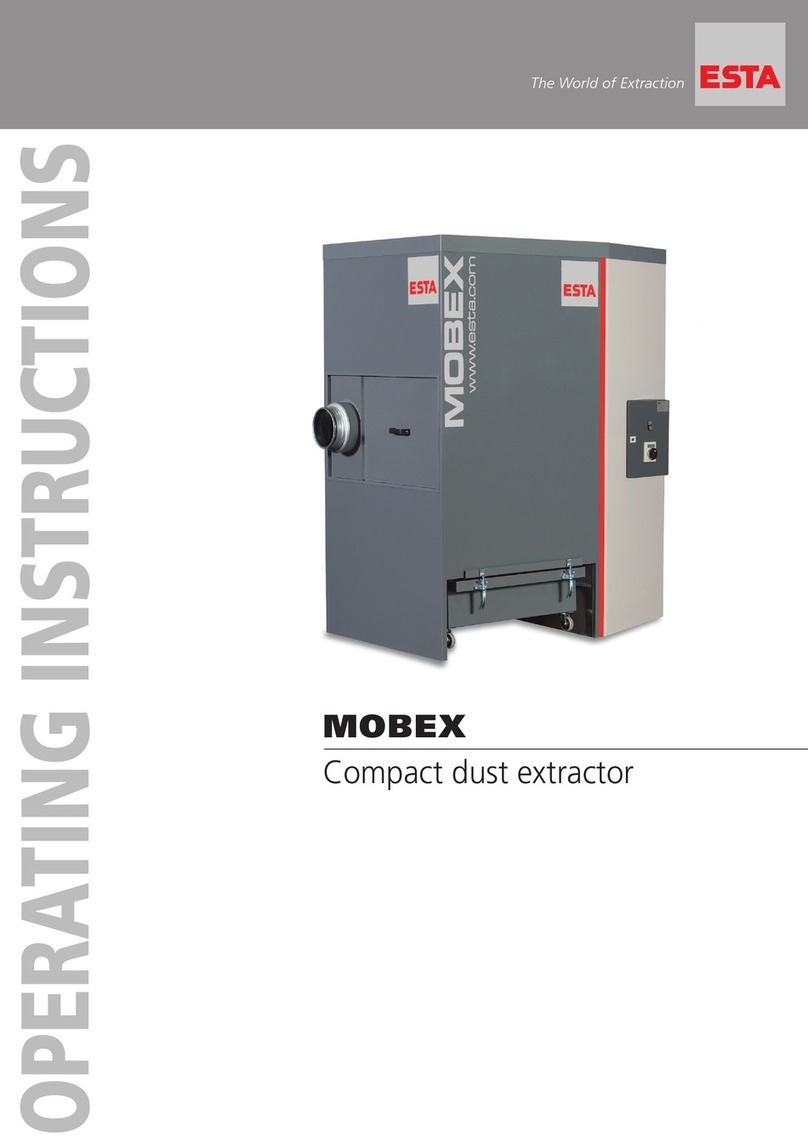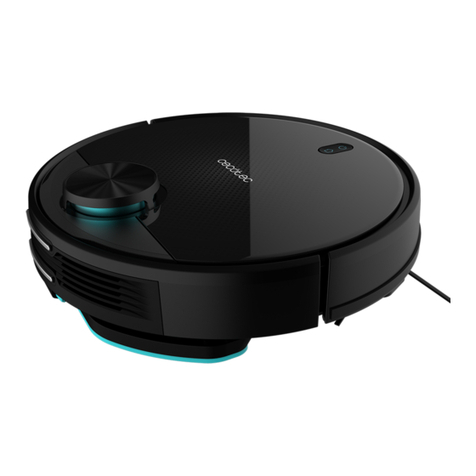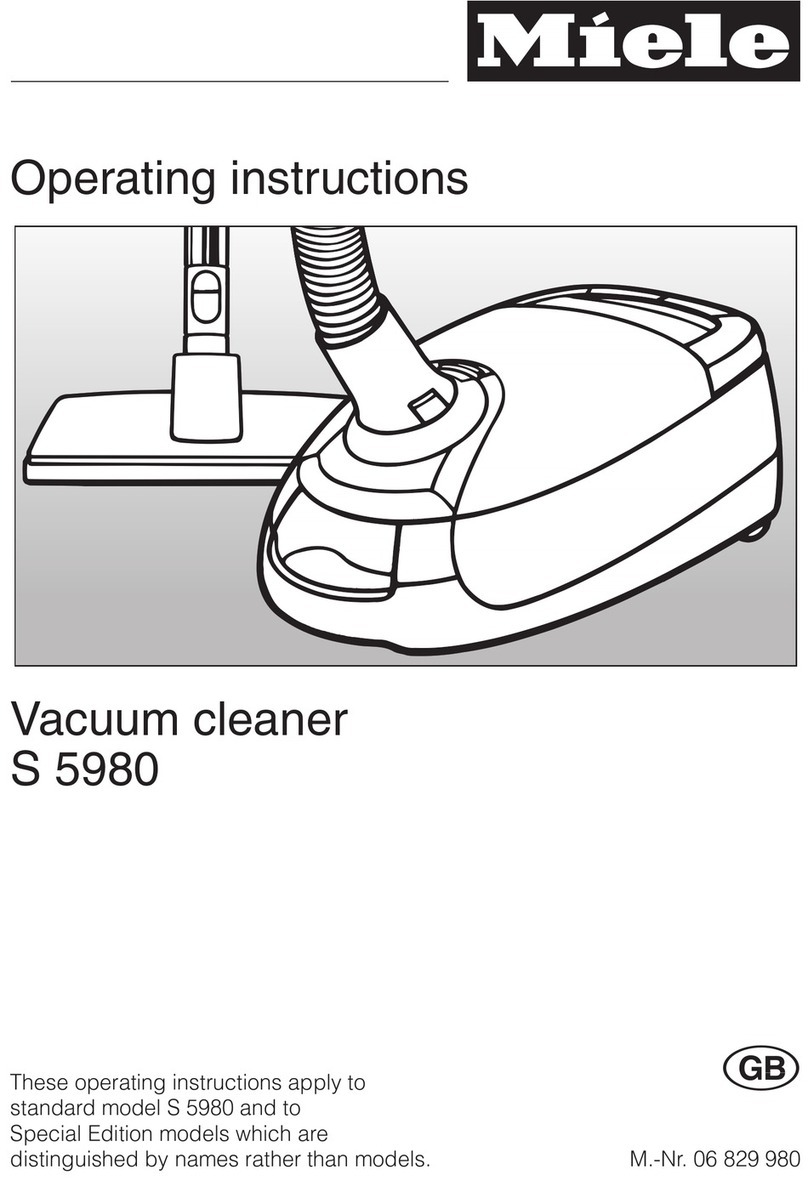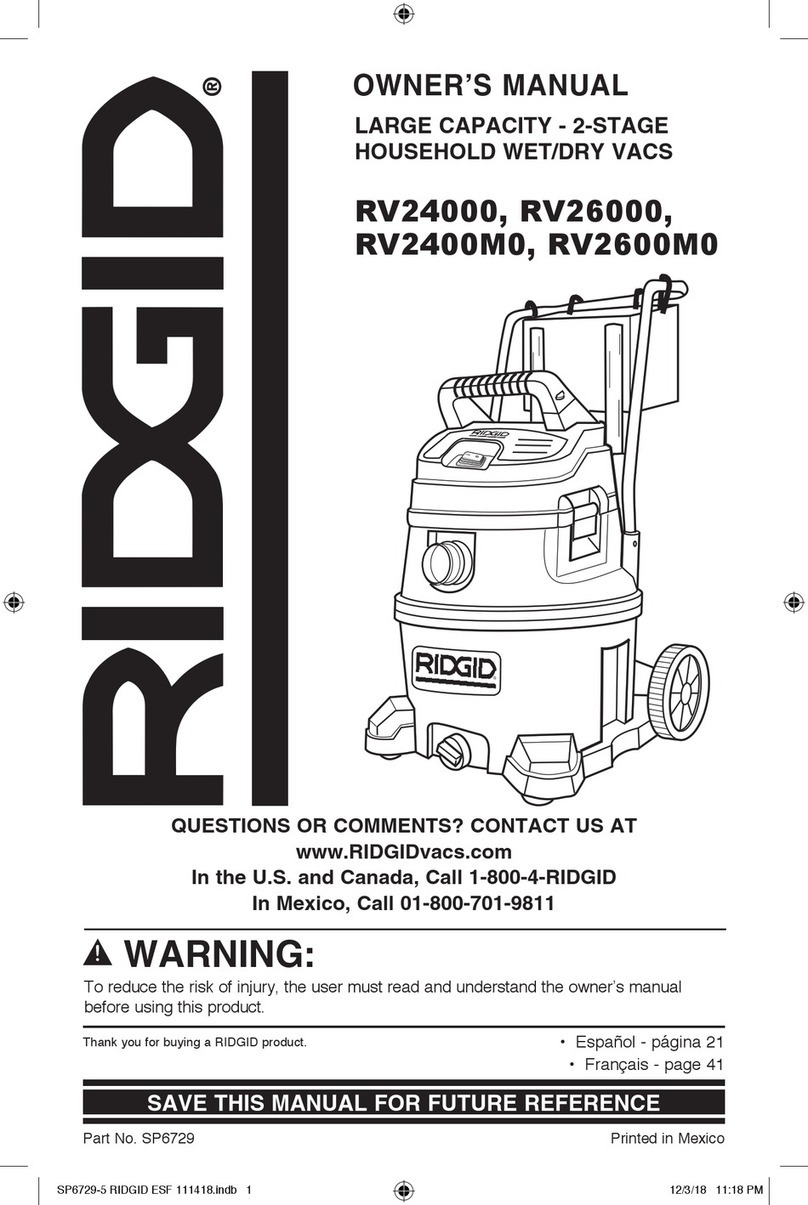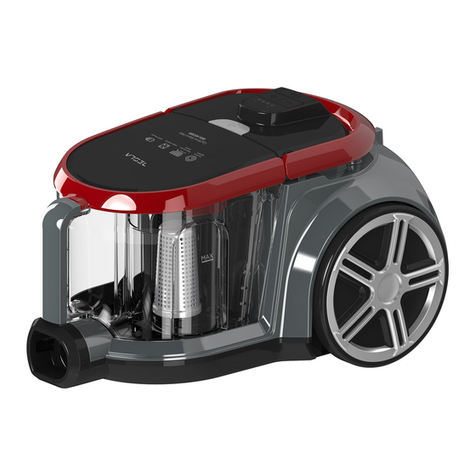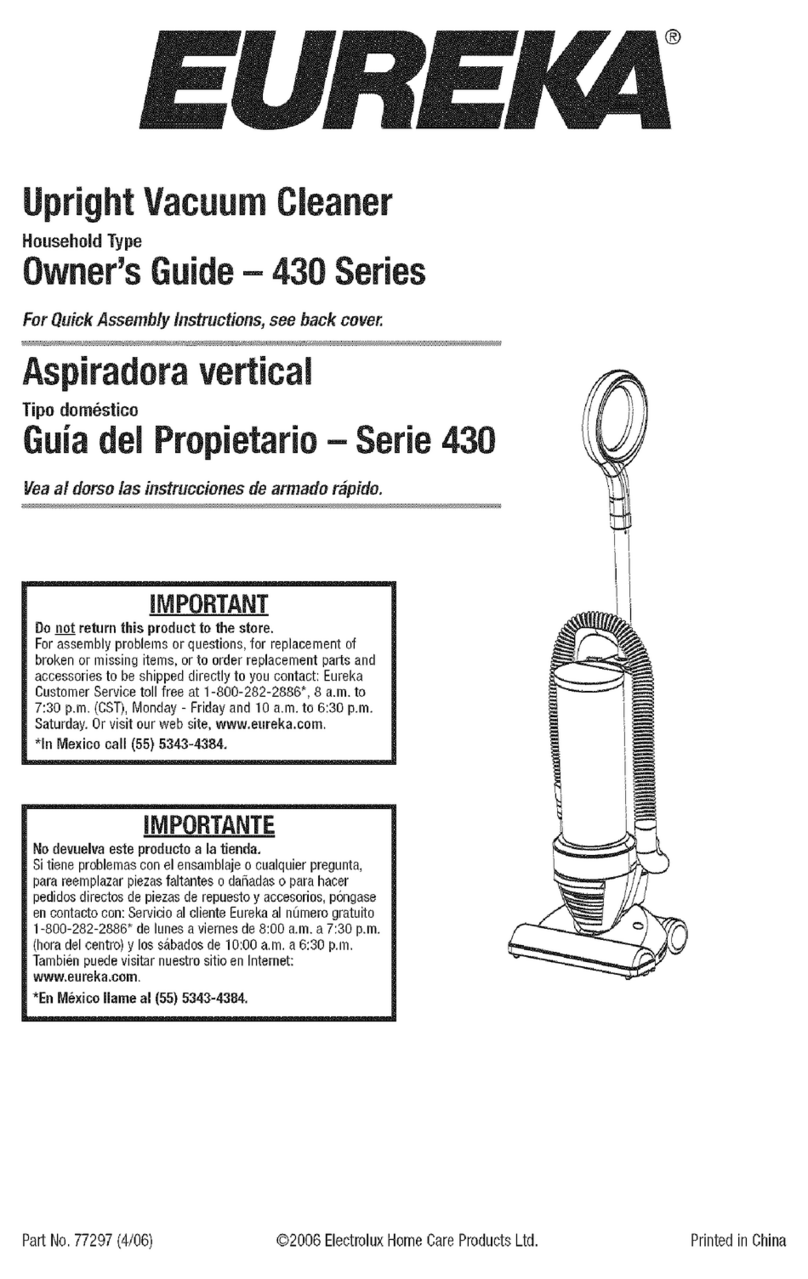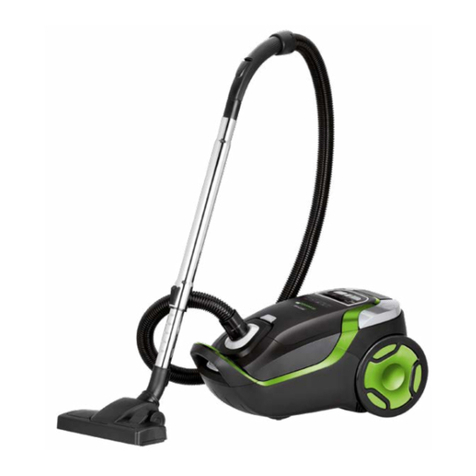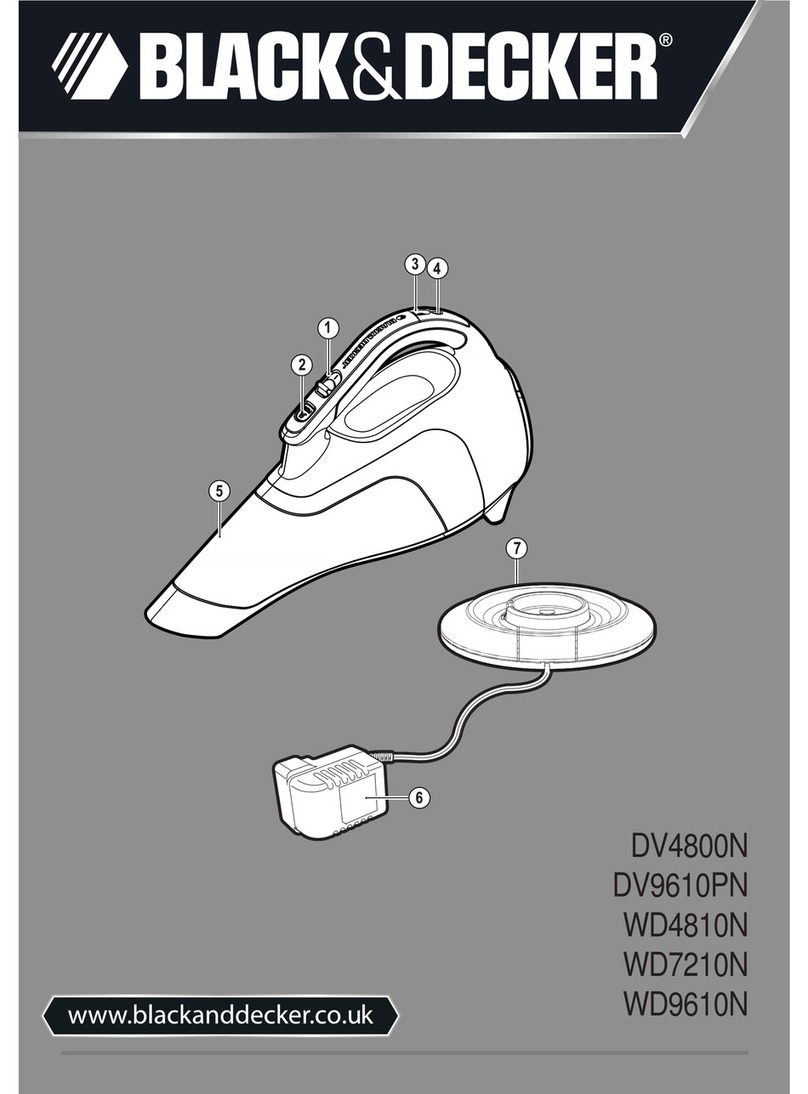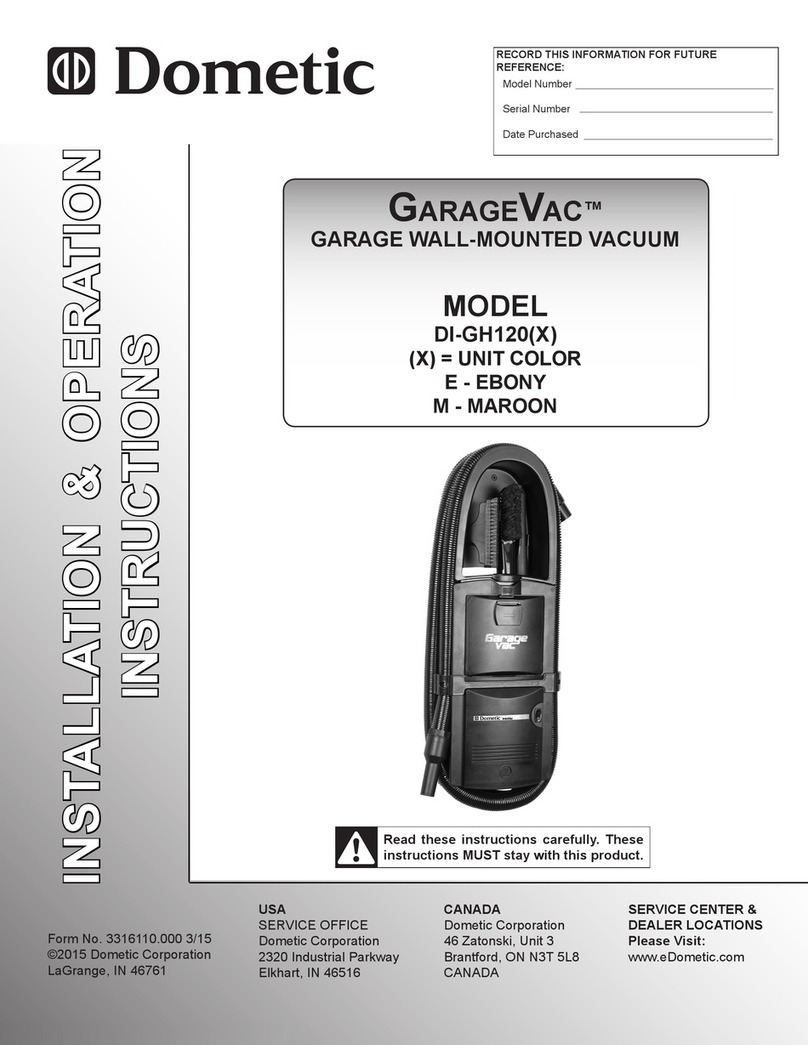Esta EUROSOG-W/N User manual

OPERATING INSTRUCTIONS
The World of Extraction
EUROSOG
Industrial Vacuum Cleaners

Your purchase of an ESTA machine has
been a good decision. The design of
our quality products complies with the
latest state of the art. ESTA products
have been devised to provide for clean
air at the workplaces at which they are
applied. This results in an even more
enhanced level of quality and longer
machine times and, particularly, healthier
working conditions. Should you have
any questions pertaining to suction tech-
nology issues, please feel free to contact
us at any time. Our experts will be gladly
at your disposal.
Your ESTA Absaugtechnik Team
The World of Extraction
www.esta.com
Welcome to the sphere of suction
technology

Operating manual
EUROSOG
Item No. 80.198 (EUROSOG-W/N)
Item No. 81.198 (EUROSOG-I-D/N)
Item No. 80.399 (EUROSOG-W/M)
Item No. 81.399 (EUROSOG-I-D/M)
Item No. 80.299 (EUROSOG-W/H)
Item No. 81.299 (EUROSOG-I-D/H)
Do not use this device unless you have
read the user manual and understand it.
Translation of the original operating manual
80198-08-03

2
EUROSOG
80198-52-03
Edition notice
Original operating manual
Document No.: 80198-08-03
Publishing date: 23.08.2016
Type of device: EUROSOG industrial vacuum cleaner
Item No.: 80.198 // 81.198 // 80.399 // 81.399 // 80.299 // 81.299 and variants
Publisher
ESTA Apparatebau GmbH & Co. KG Tel.: +49 (0) 73 07 80 4 -0
Gotenstraße 2-6 Fax: +49 (0) 73 07 80 4 -500
Germany www.esta.com
Copyright notice (per DIN ISO 16016:2007-12)
Transfer or reproduction of this document, or the use or communication of its content, is
forbidden without explicit consent. Violators will be liable for damages. All rights to patent, utility
or design registration are reserved.
Warnings and safety instructions
Electrical current hazard
Note
Reference to ESTA customer service
Reference to legal regulations

80198-52-03
EUROSOG
3
Contents
Contents .....................................................................................................................................3
1. General safety notes.............................................................................................................4
2. Preventing mechanical hazards ..........................................................................................6
3. Preventing electrical hazards ..............................................................................................6
4. Preventing dust hazards ......................................................................................................7
4.1 Devices for dust class M (EUROSOG-I-D/M, EUROSOG-W/M) ........................................7
4.2 Devices for dust class H (EUROSOG-I-D/H, EUROSOG-W/H) .......................................8
5. Intended use..........................................................................................................................9
5.1 Unintended use .................................................................................................................9
6. Technical data and description .........................................................................................10
6.1 EUROSOG-W (AC current devices)................................................................................10
6.2 EUROSOG-I-D (three-phase current devices) ................................................................11
6.3 Functional description.......................................................................................................12
7. Delivery and commissioning .............................................................................................13
7.1 Delivery ...........................................................................................................................13
7.2 Commissioning.................................................................................................................13
7.2.1 EUROSOG-W (for AC operation, all variants) ..............................................................14
7.2.2 EUROSOG-I-D (for operation with three-phase current) ..............................................14
The equipment for turning the device on and off is located on the cover of the turbine housing.
The device is turned on and off with the black rotary switch............................................14
7.3 Operation.........................................................................................................................15
8. Maintenance and troubleshooting..................................................................................... 16
8.1 Maintenance instructions.................................................................................................16
8.2 Inspection and maintenance intervals .............................................................................17
8.3 Troubleshooting................................................................................................................19
9. Monitoring the minimum airflow volume ..........................................................................20
10. Cleaning.............................................................................................................................20
10.1 Cleaning the EUROSOG’s filter manually .....................................................................21
10.2 Filter replacement...........................................................................................................21
10.2.1 Replacing the pre-filter (dust class “M”) ..................................................................22
10.2.2 Replacing the main filter (devices with the dust class “H” test certificate) ...............22
10.3 Replacement parts .........................................................................................................23
11.Disposal ............................................................................................................................... 24
11.1 Disposing of the collected dust material ........................................................................24
11.2 Disposing of the device .................................................................................................25
12. Optional equipment ..........................................................................................................25
12.1 Movable dust collection container..................................................................................25
12.2 Pre-separator ................................................................................................................26
12.3 Accessories ...................................................................................................................27
13. Device diagram ................................................................................................................. 28
13.1 Instructions and symbols ...............................................................................................29
14. EC-/EU-Declaration of Conformity................................................................................... 30
Notes.........................................................................................................................................31

4
EUROSOG
80198-52-03
1. General safety notes
Before operation, all persons who are to use the device or perform maintenance
on it must be provided with information, instructions and training in using the
device and on the substances for which it is to be used, including the procedure
for safe disposal of the collected material. Responsibilities must be clearly
established for the following:
Installation
Start-up
Operation
Maintenance and repair
The device must be used only by persons who have been instructed in its
handling and are explicitly authorized to use it.
Always keep the operating manual at the place where the industrial vacuum
cleaner is being used, so that it can be seen by personnel at all times.
The device must not be used by people (including children) with limited physical,
sensory or mental abilities or who lack experience and/or knowledge, unless they
are supervised by a person who is responsible for their safety or have received
instructions on how to use the device properly. Children must be supervised to
ensure that they do not play with the device.
The device is intended only for dry cleaning of coarse, fine and free-flowing dusts
and must not be used or stored outdoors or under wet conditions.
No liquids, aggressive gases, easily flammable materials or glowing particles
(such as hot embers) may be aspirated.
Installation and operation in dust-explosive or gas-explosive areas is
forbidden.
Only original ESTA replacement parts must be used; use of other products will
void the warranty.
During exhaust, the volume flow returned from the device into the room must be
no more than 50% of incoming air. With free room ventilation, the incoming airflow
must equal the room volume every hour. This means that the rate of air
replacement must be once per hour.
Incoming airflow [m³/h] = room volume [m³] air replacement rate [1/h]

80198-52-03
EUROSOG
5
Example:
When the ESTA industrial vacuum cleaner is operating at the nominal airflow
volume of 360 m³/h, the same volume of fresh air must therefore be fed in. This
occurs with natural ventilation if the volume of the work room is 360 m³ (e.g., 150
m² surface with a 2.4 m ceiling height).
Make sure that the power cable does not become damaged by being run over,
compressed, pulled, etc.
The power cable must be examined regularly for signs of damage or ageing.
The device must not be used if damage to the power cable is detected.
The power cable and plug must be replaced only by an appropriately trained
electrical specialist.
For the power supply and the device’s power cords, only original ESTA
replacement parts must be used. This guarantees that they are spray-proof
according to applicable standards and have the necessary mechanical strength.
The power cord must be plugged in only after the industrial vacuum has been
successfully set up at its place of use. For this, with a three-phase unit a 16-amp
CEE wall socket must be in place, or with an AC unit, a 16 A Schuko wall socket
with a slow-blow fuse.
After use, before moving the device to another site and before cleaning,
maintenance, or replacement or removal of movable parts, the device must be
unplugged.
To prevent dust release when transporting the device, the intake port must be
closed with the sealing plug.
The EUROSOG is to be moved on a stable, even surface that can securely
support a weight of 150 kg/m².
Cleaned air from the EUROSOG must be returned only to work areas from which
it was exhausted.
Only original ESTA conductive accessories may be used for operating the
industrial vacuum.

6
EUROSOG
80198-52-03
From its first use, the device contains toxic dust. Emptying and
maintenance processes, including removal of the dust collection container,
must be performed by expert personnel who are wearing appropriate
protective gear. The device must not be operated without the complete
filtration system!
According to directives 2009/104/EC and TRGS 560, safety devices for
prevention or removal of hazards must be regularly maintained and
regularly inspected by an expert for safe, flawless operation.
In all emergencies, the device must be disconnected from the power supply
immediately. Turn the device off with the emergency switch and pull the
plug. If there is a fire, the fire department is to be alerted immediately, and
the fire must be contained by appropriate means! A suitable extinguishing
agent must be kept near the device before start-up and during operation.
2. Preventing mechanical hazards
All movable machine parts driven by electric motors must be covered by fixed,
securely fastened protective covers that can be removed only with tools.
Residual risk:
If a covering that can only be unfastened with a tool is removed, there is risk
of injury if the machine is running.
3. Preventing electrical hazards
All electrical parts must be covered by fixed, securely fastened protective covers
that can be removed only with tools. The device complies with Protection Class I
according to EN 60 335.
Residual risk:
If a covering that can only be unfastened with tools is removed, a hazard is
posed by electric current.

80198-52-03
EUROSOG
7
4. Preventing dust hazards
Using a one-way dust collection bag with a closable opening guarantees low-dust
removal of the collected dust material.
Residual risk:
When emptying the dust collection bag, it is possible to inhale dust.
4.1 Devices for dust class M (EUROSOG-I-D/M, EUROSOG-W/M)
The device is designed for use with dusts that are hazardous to health. When
working on the open device (for maintenance, cleaning, repairs), the operator must
take special protective measures, which include wearing special personal
protective gear. When the device is being operated, the complete filtration system,
consisting of the main filter and backup filter must be used. The following warning
is shown on the device.
After the first time it is operated, this device contains class M dust (moderately
hazardous). The instructions contained in the operating manual for low-dust
cleaning, service, maintenance and disposal absolutely must be followed. Open
the device only when it has been turned off from the control panel, and when it has
been determined by a wait time of about 4 minutes that the filter cleaning process
has been performed and that the dust inside the device has settled in the dust
collection container. Before opening, turn the device off at the main switch and
secure it against unintentional reactivation. Using a one-way dust collection bag
with a closable opening guarantees low-dust removal of the collected material.

8
EUROSOG
80198-52-03
4.2 Devices for dust class H (EUROSOG-I-D/H, EUROSOG-W/H)
The device is designed for use with dusts that are hazardous to health. When
working on the open device (for maintenance, cleaning, repairs), the operator must
take special protective measures, which include wearing special personal
protective gear. When the device is being operated, the complete filtration system,
consisting of the main filter and backup filter must be used. The following warning
is shown on the device.
Open the device only when it has been turned off from the control panel, and when
it has been determined by a wait time of about 4 minutes that the cleaning process
has been performed and that the dust inside the device has settled in the dust
collection container. Before opening, turn the device off at the main switch and
secure it against unintentional reactivation. Using a one-way dust collection bag
with a closable opening guarantees low-dust disposal of the collected material.

80198-52-03
EUROSOG
9
5. Intended use
The ESTA industrial vacuum has been manufactured according to the state of the
art and in compliance with safety regulations. It is suitable for commercial use,
such as in industrial firms and workshops.
ESTA EUROSOG-I-D/N, EUROSOG-W/N model devices (all variants) are
equipped with a filter for dust class “M” (moderate hazard) for separation of dust
with an exposure limit > 0.1 mg/m³. The purified air can be directed back into the
work area. These devices are suitable for removal of non-flammable, dry, coarse,
fine and free-flowing dusts that are not toxic. This design is not suitable for
exhausting processing machines.
The EUROSOG-I-D/M, EUROSOG-W/M is additionally tested based on standard
EN 60355-2-69 Appendix AA for dust class “M” (moderate risk) by the TÜV
PRODUCT SERVICE.
The EUROSOG-I-D/H, EUROSOG-W/H is tested based on standard
EN 60335-2-69 Appendix AA for dust class “H” (high risk) and is suitable for
separation of any dry, non-flammable dusts with all exposure limits, including
carcinogenic and pathogenic dusts.
5.1 Unintended use
This design is not suitable for exhausting processing machines.
Installation and operation in dust explosive zones or gas explosive zones is not
permitted.

10
EUROSOG
80198-52-03
6. Technical data and description
6.1 EUROSOG-W (AC current devices)
We reserve the right to make technical changes.
Model
(see model plate)
-W/N
-W/M
-W/H
Item No.
80,198
80,399
80,299
Max. airflow volume
[m³/h]
360
Connection diameter
[mm]
50
Max. vacuum
[Pa]
18,600
Connection voltage
[V]
230
Drive output
[kW]
3 x 1
Rated current
[A]
13
Nominal frequency
[Hz]
50
Circuit breaker
[A]
16
Protection class
IP 40
Max. Sound pressure level*
[dB(A)]
74
Environmental conditions
[°C]
5 25
Max. air humidity
[%]
60
Filter area, dust class “M”
[m²]
2
2
2
Filter area, dust class “H”
[m²]
-
-
5
Dust collection container
[litres]
80
Dimensions
[mm]
920 x 655 x 1230
Weight
[kg]
74
76
Production year
See model plate.
* * using the enveloping surface method DIN EN ISO 3744, measured at minimum volume
flow; noise measurement margin of error approx. 4 dBA

80198-52-03
EUROSOG
11
6.2 EUROSOG-I-D (three-phase current devices)
We reserve the right to make technical changes.
Model
(see model plate)
-I-D/N
-I-D/M
-I-D/H
Item No.
81,198
81,399
81,299
Max. airflow volume
[m³/h]
260
Connection diameter
[mm]
50
Max. vacuum
[Pa]
19,500
Connection voltage
[V]
400
Nominal frequency
[Hz]
50
Drive output
[kW]
2.2
Rated current
[A]
4.6
Circuit breaker
[A]
16
Protection class
IP 40
Environmental conditions
[°C]
5 25
Max. Sound pressure level*
[dB(A)]
72
Max. air humidity
[%]
60
Filter area, dust class “M”
[m²]
2
2
2
Filter area, dust class “H”
[m²]
-
-
5
Dust collection container
[litres]
80
Dimensions
[mm]
1050 x 670 x 1240
Weight
[kg]
81
83
Production year
See model plate.
* * using the enveloping surface method DIN EN ISO 3744, measured at minimum volume
flow; noise measurement margin of error approx. 4 dBA

12
EUROSOG
80198-52-03
6.3 Functional description
AC operation: EUROSOG-W
The EUROSOG-W is equipped with three turbines, each driven directly by
universal engines. The all-pole main switch supplies or cuts off the necessary
power to the device, and the motors are turned on and off sequentially with the
three green toggle switches.
Based on the vacuum created by the turbine, air is sucked through the intake
fitting on the filter housing or through a suction piece connected to the intake
fitting. A permanent “M” filter set up within the filter housing separates the dust
that is in the exhausted air. The purified air is guided back into the room through
the exhaust vents.
A crank on the filter housing is used for cleaning the filter. The crank drives a
brush strip that runs over the filter folds and in this way removes dust clogged into
the folds. The removed dust is caught in the dust collection container.
For removal of the collected dust material, the upper part can be tipped backwards
and the dust collection container removed from the device complete with its
contents.
Category “H” devices with a test certificate have a backup filter in addition to the
filter described above. It is this filter that allows the device to comply with dust
class “H”. It cannot be cleaned, so when necessary it must be replaced.
On tested devices of dust classes “M” and “H”, there is a manometer built
into the cover that displays the vacuum behind the filter.
With increased dust soiling of the filter, the flow resistance increases along
with the vacuum behind the filter. If the manometer’s indicator enters the red
zone, the EUROSOG’s suction performance is no longer adequate and the
filter must be cleaned.
Operation with three-phase current:
The EUROSOG-I-D works in the same way but is equipped with a 3kW three-
phase asynchronous motor that is turned on and off by an all-pole main switch.
The motor uses a poly-V belt to drive the suction turbine.

80198-52-03
EUROSOG
13
7. Delivery and commissioning
7.1 Delivery
At delivery, the EUROSOG is fastened to a pallet. After the protective cover and
the bottom fasteners have been removed, the device can be picked up with a
forklift. Please do not use a crane.
Upon delivery, please inspect the device for transportation damage. Damage
determined must be reported and documented immediately.
Never use a crane for transport!
ESTA customer service: +49 (0) 7307 804 - 0
When moving the device, make sure the ground can support it and be driven
over.
7.2 Commissioning
Only persons authorized under “General safety instructions” must turn the
device on.
Before setting up the cable connection between the device and the power
grid, check to make sure the operating voltage shown on the model plate is
the same as that of the grid.
Before the device is used, its operation must be tested.

14
EUROSOG
80198-52-03
7.2.1 EUROSOG-W (for AC operation, all variants)
The equipment for turning the device on and off is
on the side of the turbine housing. Pressing the
main switch’s green button supplies the device with
power, and the red button shuts it off. The device
has three green rocker switches. Each turbine is
turned on individually by its own rocker switch. Each
rocker switch lights when its turbine is turned on.
If all rocker three switches are at the “I” position and
the device has been wrongly turned on at the main
switch, in adverse situations the fuse to the power
grid can be tripped. It is recommended that the
turbines be turned on individually and
sequentially using the green rocker switches. To
run the device as intended, all turbines must be turned on.
7.2.2 EUROSOG-I-D (for operation with three-phase current)
The equipment for turning the device on and off is
located on the cover of the turbine housing. The device
is turned on and off with the black rotary switch.
Be aware of the direction of rotation!
Before commissioning, make sure that the turbine’s direction of rotation is correct.
Meanwhile, also look at the red light on the switch. If this lights up after the device
is turned on, the direction of rotation is wrong, and the power supply’s polarity
must be reversed. For this purpose, the CEE plug is equipped with a phase
inverter. Using a screwdriver to turn the pole pin built into the insulated part of the
plug changes the motor’s direction of rotation.
When the direction of rotation is wrong, the device gets impermissibly hot,
the airflow volume gets weaker, and the device’s performance suffers. This
can also damage the device.
Rocker switch
Main switch

80198-52-03
EUROSOG
15
7.3 Operation
If a function check is performed, the correct ESTA suction accessory parts must
be connected to the intake fitting for commissioning the EUROSOG. This consists
of a suction hose, a handheld tube and a nozzle. The end of the suction hose,
which is reinforced with a coil spring, is inserted into the intake port of the
industrial vacuum. The other end is connected to the sleeve of the handheld tube
or a hand-guided suction nozzle. For cleaning the floor, connect the handheld tube
to the floor vacuuming attachment. The EUROSOG is now ready to operate.

16
EUROSOG
80198-52-03
8. Maintenance and troubleshooting
8.1 Maintenance instructions
For maintenance by qualified personnel, the device must be opened, cleaned and
inspected at the given locations, as well as possible, without any hazard being
posed to maintenance personnel or other persons. Proper precautions must be
taken before cleaning and removal of wearing parts. This includes locally filtered
forced-air ventilation in the area in which the device is being maintained, and
proper personal protective gear. This consists of a dust mask with a class P3
particle filter, protective clothing (e.g. an appropriate disposable safety suit) and
safety gloves.
All distractions by uninvolved persons and the environment must be
prevented.
During maintenance or repair work, all soiled objects that can no longer be
adequately cleaned must be disposed of. Such objects must be disposed of in
impermeable dust bags in compliance with applicable regulations for disposal of
such refuse.
If the EUROSOG is not needed in its location of use for a long time, it must be
stored in a dry room. The temperature should not be below 5°C or above 25°C.
It is best to clean the device before storing it. To do this, clean the filter and empty
the dust collection container. Then the device must be thoroughly cleaned with a
suitable industrial vacuum cleaner. Optionally, the device can also be cleaned with
a damp cloth.
The device must never be cleaned with flowing water.
Service, maintenance and cleaning must be performed according to accident
prevention regulations. Before this work is performed, the device must be
switched off and disconnected from the power grid! Pull the electrical plug!

80198-52-03
EUROSOG
17
8.2 Inspection and maintenance intervals
The operator is obligated to have a technical inspection performed once per year.
This involves a specially trained person checking the entire device for correct
operation. It includes checking the filter for damage, the airtightness of the device,
and correct operation of the control module. Additionally, for dust class H devices,
the device’s filtration effectiveness should be checked at least annually, as can be
determined by national requirements. The inspection process that can be used for
certifying the device’s effectiveness is specified in DIN EN 60335-2-69
AA.22.201.2. If the device does not pass this test, it must be repeated with a new
main filter.
Regular maintenance consists of 3 intervals:
1. Daily inspection includes:
By the device’s user
Visual inspection
for damage to the device or its parts,
for mechanical damage to the power cable,
for a full dust collection container (regulations require that the container be
emptied if it is more than 2/3 full).
2. Monthly inspection includes:
By expert maintenance personnel
Functional and visual inspection
for filter leaks (dust trails or deposits on the air outlets),
when available, to guarantee operation of the minimum airflow volume
monitor (manometer or pressure controller). During inspection, the device’s
air intake must be closed.
3. The main annual inspection includes:
The last test by ESTA is documented on the device.
In collaboration with the ESTA maintenance service
Flow volume measurement
Vacuum measurement
Current consumption measurement
Visual check of filters
Seal inspection
After maintenance, the device receives a new test plate as documentation.

18
EUROSOG
80198-52-03
In the included maintenance book, records must be kept of the service and
maintenance work, and of the main annual inspection. This must make clear
the equipment inspected and, if necessary, the deficiencies found, along
with the name of the inspector and the date of the inspection. The date of
the next main inspection can be read from the inspection plate installed on
the device.
If there is a malfunction, the industrial vacuum must be switched off
immediately and the responsible maintenance service notified!
Maintenance must be performed according to accident prevention
regulations. The device must be disconnected from the power supply!
According to work equipment user directives 2009/104/EG and TRGS 560,
safety devices for prevention or removal of hazards must be regularly
maintained and regularly inspected by an expert for safe, flawless operation.
Get the most from ESTA’s maintenance service!
A maintenance contract ensures a long life and top-notch operation for your
industrial vacuum.
We’ll make you a great offer — just call us up:
ESTA maintenance service: +49 (0) 7307 804 - 0
ESTA replacement part service: +49 (0) 7307 804 - 0
This manual suits for next models
11
Table of contents
Other Esta Vacuum Cleaner manuals
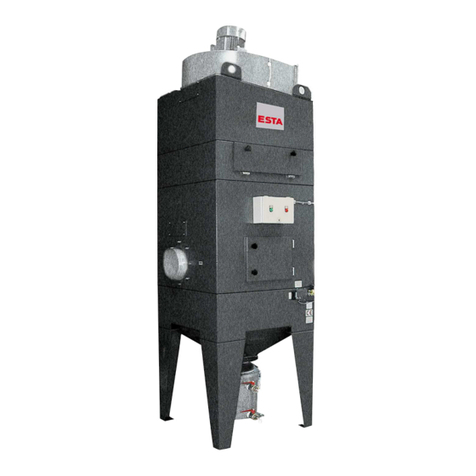
Esta
Esta NA-K B/VA User manual

Esta
Esta DDE 1500 User manual
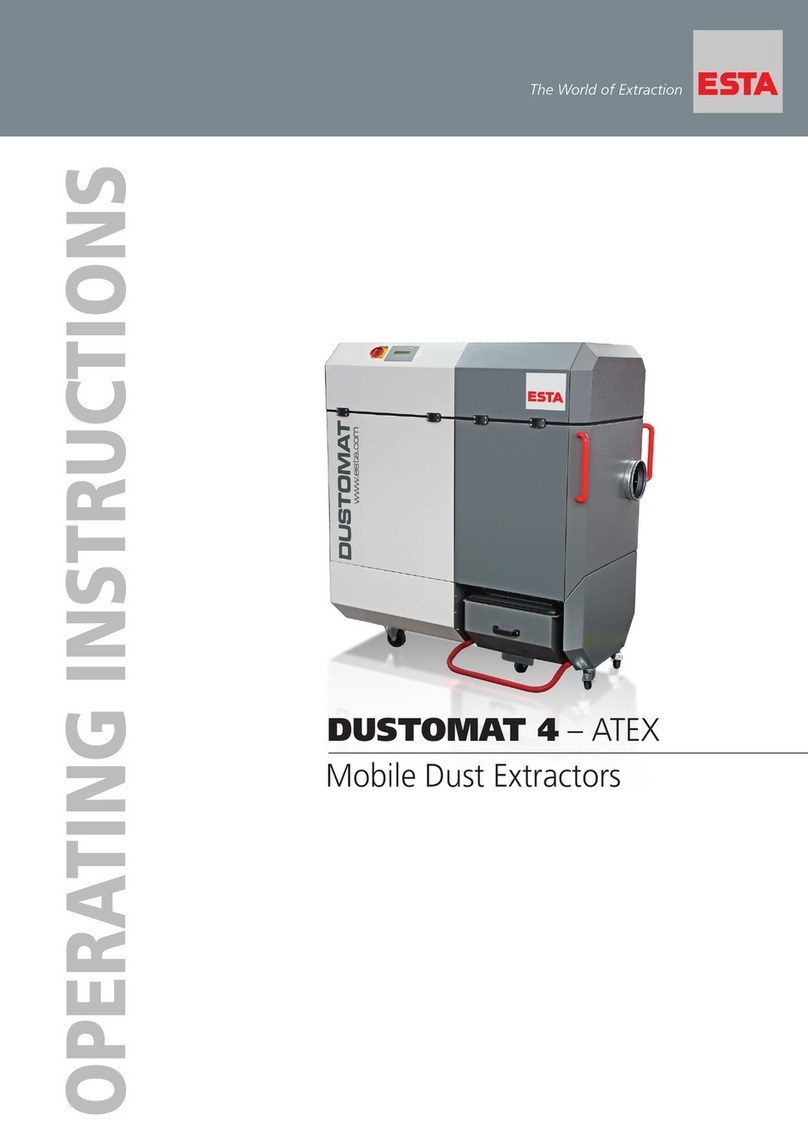
Esta
Esta DUSTOMAT 4 ATEX User manual

Esta
Esta DUSTOMAT-160 S User manual
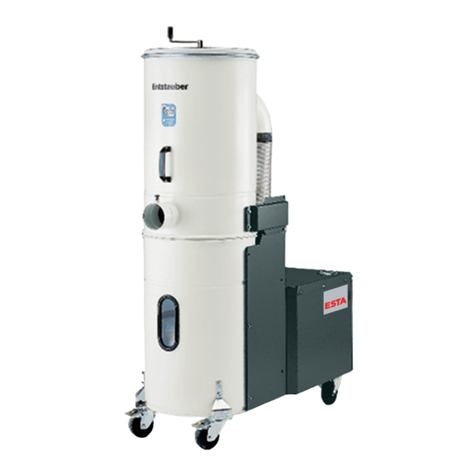
Esta
Esta DUSTOMAT-10 User manual

Esta
Esta DUSTOVAC 5.5 FM User manual
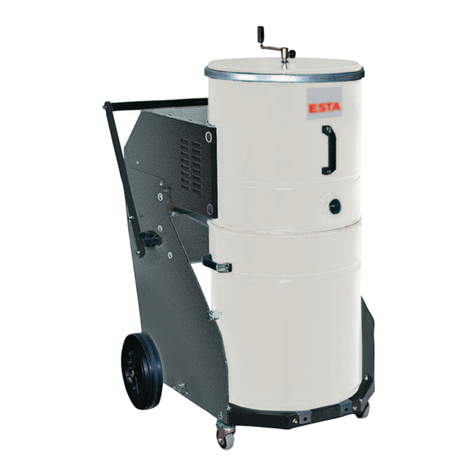
Esta
Esta EUROSOG - ATEX User manual
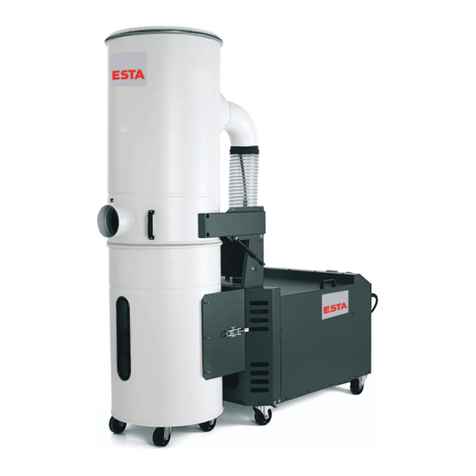
Esta
Esta DUSTOMAT-21 User manual

Esta
Esta NA-K User manual

Esta
Esta WHISPERSOG User manual
